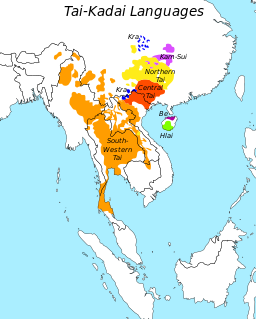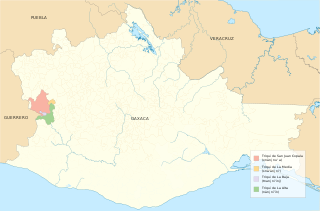
The Kra–Dai languages are a language family of tonal languages found in Mainland Southeast Asia, Southern China and Northeast India. They include Thai and Lao, the national languages of Thailand and Laos respectively. Around 93 million people speak Kra–Dai languages, 60% of whom speak Thai. Ethnologue lists 95 languages in the family, with 62 of these being in the Tai branch.

SIL International is a evangelical Christian non-profit organization whose main purpose is to study, develop and document languages, especially those that are lesser-known, in order to expand linguistic knowledge, promote literacy, translate the Christian Bible into local languages, and aid minority language development.

Uto-Aztecan, Uto-Aztekan or (rarely) Uto-Nahuatl is a family of indigenous languages of the Americas, consisting of over thirty languages. Uto-Aztecan languages are found almost entirely in the Western United States and Mexico. The name of the language family was created to show that it includes both the Ute language of Utah and the Nahuan languages of Mexico.

Kalinga is a dialect continuum of Kalinga Province in the Philippines, spoken by the Kalinga people, alongside Ilocano. The Banao Itneg variety is not one of the neighboring Itneg languages.

The Triqui, or Trique, languages are a family of Oto-Manguean spoken by 30,000 Trique people of the Mexican states of Oaxaca and the state of Baja California in 2007. They are also spoken by 5,000 immigrants to the United States. Triqui languages belong to the Mixtecan branch together with the Mixtec languages and Cuicatec.
Andrew Kenneth Pawley, FRSNZ, FAHA, is Emeritus Professor at the School of Culture, History & Language of the College of Asia & the Pacific at the Australian National University. Pawley was born in Sydney but moved to New Zealand at the age of 12.
The Kam–Tai languages, also called Dong–Tai or Zhuang–Dong in China, are a proposed primary branch of the Kra–Dai language family. The Kam–Tai grouping is primarily used in China, including by the linguists Liang & Zhang (1996).
Huasteca Nahuatl is a Nahuan language spoken by over a million people in the region of La Huasteca in Mexico, centered in the states of Hidalgo (Eastern) and San Luis Potosí (Western).
Khaling is a Kiranti language spoken in Solukhumbu district, Nepal and Sikkim, Darjeeling, and Kalimpong in India. It is one of the few Kiranti languages with tonal contrasts, which are of secondary origin.
A language survey is conducted around the world for a variety of reasons.
Ai-Cham is a Kam–Sui language spoken mainly in Diwo 地莪 and Boyao 播尧 Townships, Jialiang District, Libo County, Qiannan Prefecture, Guizhou, China. Alternative names for the language are Jiamuhua, Jinhua and Atsam. Fang-Kuei Li first distinguished the language in 1943. Nearby languages include Bouyei and Mak. However, Yang (2000) considers Ai-Cham and Mak to be different dialects of an identical language.
The Southern Tiwa language is a Tanoan language spoken at Sandia Pueblo and Isleta Pueblo in New Mexico and Ysleta del Sur in Texas.
Semantic structure analysis is a methodology for systematic description of the intended meaning of natural language, developed by the Summer Institute of Linguistics. The name is also used for Eugene Nida's technique for mapping lexical items from a source language to a receptor language in translation theory.
The Inabaknon language, also known as Abaknon, Abaknon Sama, Capuleño, Kapul, or Capul Sinama, is an Austronesian language primarily spoken in the Island Municipality of Capul of Northern Samar, in the Eastern Visayas Region of the Philippines.
The Mak language is a Kam–Sui language spoken in Libo County, Qiannan Prefecture, Guizhou, China. It is spoken mainly in the four townships of Yangfeng 羊/阳风乡, Fangcun 方村, Jialiang 甲良, and Diwo 地莪 in Jialiang District 甲良, Libo County. Mak speakers can also be found in Dushan County. Mak is spoken alongside Ai-Cham and Bouyei. The Mak are officially classified as Bouyei by the Chinese government.
The Burarra language is an Australian Aboriginal language spoken by the Burarra people of Arnhem Land. It has several dialects.
Nùng is a Tai–Kadai language spoken mostly in Cao Bằng and Lạng Sơn provinces in Vietnam. It is also known as Highland Nùng, Nong, Tai Nùng, Tay, and Tày Nùng. Nùng is the name given to the various Tai languages of northern Vietnam that are spoken by peoples classified as Nùng by the Vietnamese government. The Nùng were originally Zhuang people who migrated into Vietnam in the 16th and 18th centuries.

Kagate is a language from the subgroup of Tibetic languages spoken by the Kagate people primarily in the Ramechhap district of Nepal.

Balangao or Balangaw is an Austronesian language spoken in northern Luzon, Philippines. It is spoken in the central area of Mountain Province, and into Tanudan municipality of Kalinga Province.
Iduna is an Austronesian language spoken on Goodenough Island of Milne Bay Province of Papua New Guinea.






